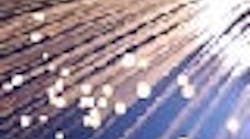FIBEROPTICS IS an ideal transmission media for many industrial applications because of its resistance to EMI/RFI and high bandwidth. “Industrial automation engineers, who design process control networks exposed to EMI/RFI, will increase their use of fiber to avoid costly network downtime and transmission delays,” says G. Pino Porciello, director of marketing at RuggedCom.
If you specify a fiber-based media, you’ll want to know a few things about installation. Fiberoptic cable should be relatively straightforward to install and can be simpler than copper cable installations because proximity to EMI/RFI can be ignored.
However, fiberoptic connectors present a potential problem in fiberoptic networks. Cables can be purchased with factory-installed connectors, but they require all lengths to be pre-measured with a high degree of accuracy. This can be quite difficult, especially for longer cable runs.
If factory-installed connectors can be used, the network performs better, is easier to maintain, and is more reliable. “Factory-installed connectors have better optical performance, which translates to higher bandwidth and fewer transmission errors,” says David Rifkin, product marketing manager at Molex Fiber Optics.
He explains that better performance comes from factory-based polishing processes and finished ferrule and fiber end-faces, which allow optimum fiber-to-fiber contact. “The factory environment is set up to ensure consistency of the final product using optimized procedures, highly trained production personnel, and specialized tooling,” adds Rifkin.
|
Fiberoptic cable should be relatively straightforward to install and can be simpler than copper cable installations because proximity to EMI/RFI can be ignored. |
For standard epoxy-type field terminations, customized hand-tools can usually perform adequate field termination and polishing. These tools include cable and fiber stripping tools, epoxy and epoxy syringe, curing oven, crimp tool, fiber cleaver or scribe tool, polishing tool, polishing films, and a microscope for visual inspection.
If anaerobic connector systems are used, the curing oven can be eliminated, as well as the need for electricity during the termination. If a higher-quality end-face is required, portable polishing machines are available.
For most field-installed connectors, installers rely on visual inspection to determine the quality of the termination. This can be misleading because it only evaluates the fiber’s surface finish, and can miss defects such as broken fiber inside the connector, macro-bending, or micro-bending.
Fiberoptic test sets allow installers to optically measure the insertion loss and return loss of the cable. The installer normally will need access to both ends of a terminated cable to perform this level of testing.
Rifkin adds that fiberoptic terminations require some finesse and learning the feel of inserting fiber into a connector without it breaking off inside. Installers must know not to use too much epoxy, which can cause the connector to freeze up. They need to master hand- or machine-polishing techniques to get the best possible end-face finish. Visual inspection of the final polished connector through a microscope also is critical.
Fiberoptic terminations must be protected during the operational life of the assembly. Dust, dirt and oils are obvious problems, but contamination also can come from other sources such as water condensation, cleaning chemicals and lubricants.
There are several ways to protect fiberoptic interfaces from contamination during operation including sealed enclosures, potting, and sealing glands. These solutions, however, limit the user’s ability to connect and disconnect the interface.
Another solution is to use a water/dust-sealed industrial interconnect. The most common and widely used is a military-grade, hardened interconnect such as a Mil-C shell with optical terminals. The disadvantages of military-grade connectors are long lead times and costly over-design that discourage use for typical industrial applications.
An industrial-grade optical connector is more economical and provides an IP67-rated seal that protects against water spray, short-term water immersion, and dust.
Recent advances in fiberoptic connectors include combining fiber for signal communication and copper for power, allowing one connector and cable to completely power and control remote applications. Future development will allow direct connection to optical transceivers in industrial environments, further reducing installation costs.
“The industrial environment will continue to require more bandwidth for inspection, video monitoring, and real-time process control. This will drive enhanced fiberoptic networks with higher fiber counts and added features,” concludes Rifkin.





